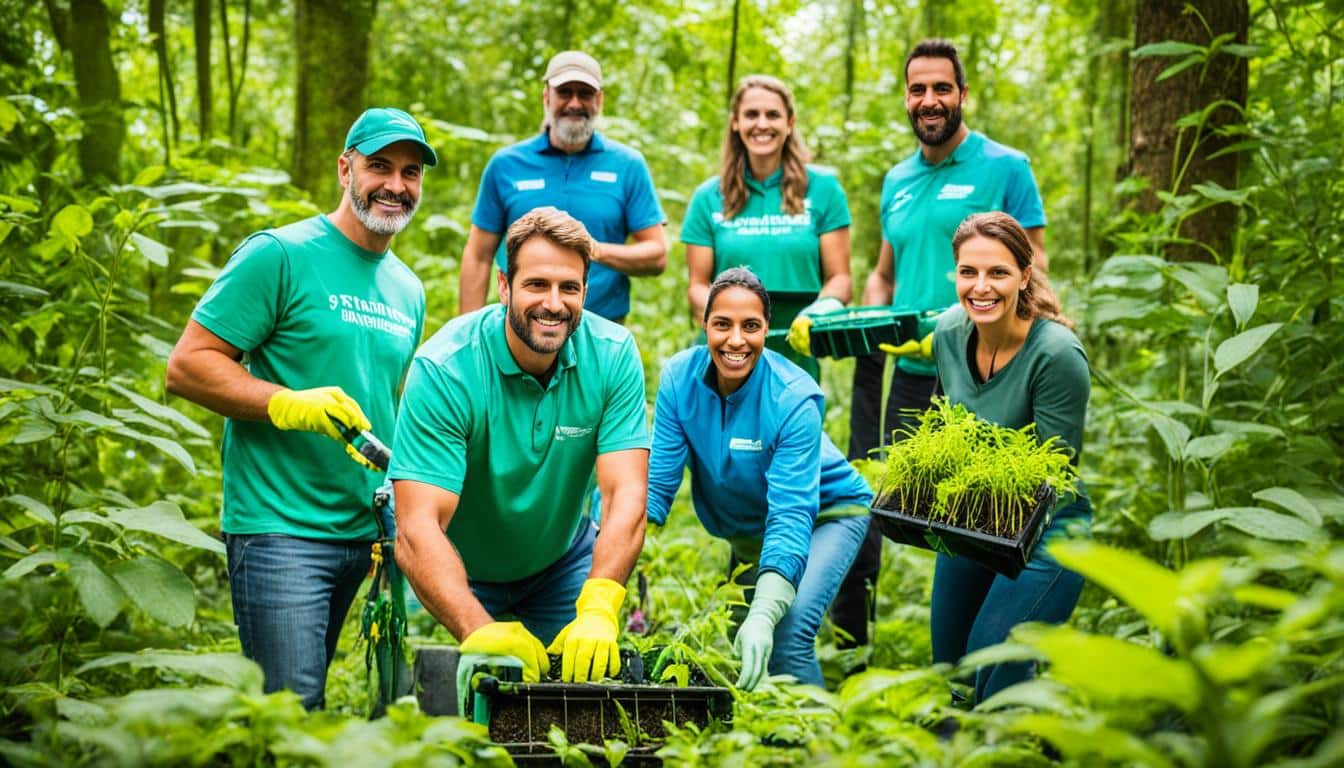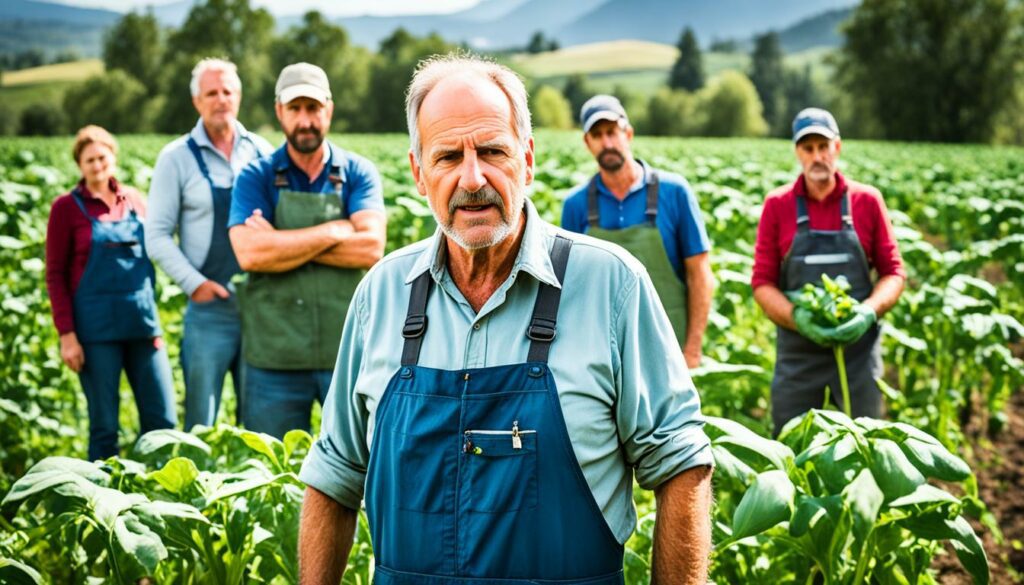Menu

Growers became 28% more confident in their pesticide choices after joining the Oregon Cranberry School’s Pesticide Resistance Management Workshop in 2018. This number shows how educating people can do big things for pest control. The challenge with pests, like bugs or weeds, is that they change over time. So, our strategies have to change too, keeping up with their moves and the climate.
Dr. Vijay Nandula from NIFA says we need new, flexible ways to control pests, especially because they’re showing up in places they never did before. This change is thanks to climate change. So, we need strong, smart ways to keep pests in check. The key, NIFA says, is to use Integrated Pest Management (IPM). This method mixes different tools, from using plants in a special way to choosing the right bugs to fight the bad ones.
Taking care of pests can also mean changing when we plant, what we use on the soil, and even letting in some animals that can eat the pests. There are also cool machines that can get rid of weed seeds when we harvest, without needing chemicals. Dr. Todd Gaines has shown that lining fields with certain kinds of plant waste can really help. These ideas show how we can protect the land and use less bad stuff to kill pests.
Collaborative pest management brings together different groups to deal with pests. These groups include local authorities, pest experts, and the public. It was started in 1959 to show that using only chemicals to control pests has drawbacks. So, it suggests using several methods together. This keeps pest numbers low but doesn’t get rid of them completely. It’s a complete and long-lasting way to tackle pest problems.
Collaborative pest control is a big plan that everyone is part of. It includes local leaders and ordinary people. They use various ways to handle pests, like changing habits, using other animals, or machinery. This makes sure we don’t just rely on chemicals. It’s a plan that looks after nature and our health.
Working together on pests helps everyone stay healthy. In Q3 2023, there were 32 cases of a disease linked to water. Less use of chemicals means we eat and drink safer things. It also helps our world stay clean. For example, with fewer chemicals, there were fewer tick-born illnesses. In Q3 2023, there were less Lyme disease cases than the year before. This shows why we must work on pest control together.
Reducing the use of chemicals is good for nature. This method saves useful species, cuts the bad impact of pest control, and supports many kinds of life. For example, more Lyme disease happened in some UK areas because ticks like those places. Understanding the local environment is key. Working together well on pest control can help lower disease spread between animals and people.
Integrated Pest Management (IPM) is a detailed and strategic way to handle pests. It combines many control methods, including mechanical, cultural, biological, and chemical solutions. These methods aim to control pests while still supporting sustainable farming practices.

IPM is built on key ideas for managing pests that care for the environment. It uses a mix of traps, crop rotation, introducing natural enemies, and careful use of chemicals. By focusing on preventing problems, it’s not just the best for the planet but it’s also a cost-effective strategy.
Setting up an IPM plan starts with understanding all pest control options. This includes finding pests, keeping an eye on how many there are, and deciding when action is needed. For over 65 types of crops, the UC Statewide IPM offers great guidance on spotting and tracking pests effectively.
One big goal of IPM is to use fewer pesticides. It does this by mixing different methods together. For example, picking the right plants and planting them in a smart way can help control pests. This approach makes sure the methods used are both safe and effective.
| Category | Examples | Benefits |
|---|---|---|
| Cultural | Crop rotation, soil preparation | Disrupts pest life cycles, promotes crop health |
| Mechanical | Traps, tillage | Physically removes pests, reduces pesticide use |
| Biological | Natural predators, parasitoids | Utilizes ecosystem services, reduces chemical dependency |
| Chemical | Judicious pesticide use | Effective when aligned with other methods, minimises resistant strains |
Working together, local authorities, farming experts, and locals join forces against pests. It’s vital to involve everyone for lasting success in pest control partnerships.
Bringing local councils on board helps create a strong plan for dealing with pests. They offer rules and funds to support united efforts against pests. An example is how Arrow Exterminators, Rentokil Terminix, and Rollins, Inc. work with councils to better pest control in their areas.
It’s crucial to get the community involved in battling pests, too. People are taught to watch for and report pests, boosting proactive pest control. This joint effort makes pest control faster and more effective. Sponsorship from leaders in the field helps people learn how to protect their areas. This not only tackles pests but also makes people feel they have a part in keeping their homes safe from pests.
There are success stories when groups team up against pests. For example, Colorado State University and Iowa State University saw big wins by using clever ways to keep pests in check. They used things like controlling weed seeds and planting cover crops in smart ways. These stories show how sharing what we know can lead to real changes in pest control. It also gets councils and locals more involved in fighting pests, which is great for the whole community.
| Company | Role in Pest Control | Key Contributions |
|---|---|---|
| Arrow Exterminators | Industry Leader | Sponsorship and Education Programs |
| Rentokil Terminix | Industry Leader | Regulatory Support and Resource Allocation |
| Rollins, Inc. | Industry Leader | Community Engagement Initiatives |
Sustainable pest prevention aims to keep nature in balance. It cuts down on using chemicals and looks after the environment. There are cultural, biological, and mechanical ways to control pests. Each method helps keep our world green and our pockets happy.

Changing how we grow our crops is key in sustainable pest prevention. It includes things like switching crops around and planting at different times. This messes up the pests’ life plans. They get fewer chances to munch on their favourite foods. It’s not just about the plants, but the whole area stays healthier too.
This approach uses nature to fight pests. We bring in good bugs or tiny organisms that attack the bad ones. An example is using lady beetles to eat aphids. This keeps the ecosystem in check without harmful chemicals. Nature fights pests naturally, keeping the environment balanced.
Mechanical methods involve using hands-on techniques to beat pests. This could mean setting up traps or using equipment to take out weeds. These methods, along with others, make a strong defence against pests. Going nonchemical helps us stay healthy. It’s a powerful way to keep pests away.
| Control Type | Strategy | Impact |
|---|---|---|
| Cultural Pest Control | Crop rotation, adjusted planting dates | Disrupts pest life cycles; enhances crop resilience |
| Biological Pest Solutions | Use of predators, parasitoids, pathogens | Maintains ecological balance; reduces need for chemicals |
| Mechanical Pest Management | Traps, cultivation practices like discing | Physically reduces pest presence; avoids pesticide-related illnesses |
Climate change is changing how we deal with pests. As they find new places to live, we need new ways to manage them. To protect our crops, we have to understand and use fresh approaches against pests.
The effect of climate change on pests is big. They can quickly get used to different weather. For over 60 years now, pests have been moving towards the colder zones at about 3 km each year. This quick change means farmers must always update how they keep these pests in check.
For example, the southern pine beetle is moving north because of warmer winters. It’s expected to reach the northeastern US and parts of Canada by 2050. Also, wheat rusts are attacking wheat more aggressively as they get used to the heat.
Climate change is letting pests spread to new areas. This means places once untouched are now battling new pest problems. Tar spot, for instance, was first found in the US in 2015, coming from Latin America.
This change is worrying as up to 40 percent of food crops can be lost to pests each year. With winters getting warmer, pests can now survive all year and reproduce more. This makes the pest problem even bigger.
To tackle pests better because of climate change, we need new ways. This includes using models to predict when pests will appear. Then, farmers can change how they plant to avoid these pests.
There’s a call for a worldwide system that keeps an eye on pests and diseases. This would make it easier to act fast when problems show up. With technology improving, we can now use things like remote systems and satellite images to fight pests better.
With climate change making pest control tougher, we need to be more creative and sustainable. It’s about protecting the environment and making sure we still have enough food.
Community-based pest management uses local efforts to control pests. It involves people from the community, farming experts, and those interested. Together, they make plans to control pests in a way that lasts. This method focuses on local action and teaching, so communities are ready to stop pests before they become a big problem.
Local efforts by farmers and experts form the basis of successful pest control in the community. In places like the Pacific Northwest, cranberry farmers have learned the need for better pest control. This isn’t just about protecting their crops; it’s also key to preserving the local environment. A meeting in 2017, where 22 experts got together, showed just how important community work is. They created a guide for pest control education, research, and rules. This showed the power of working together from the ground up.
Teaching people about pest control is vital for the community’s success. A workshop in 2018 improved growers’ confidence by 28% in choosing the right pesticides. It also pushed over 80% of them to think about using different types of pesticides over time. Sharing this knowledge locally helps everyone get better at controlling pests. It spreads good practices among farmers and their communities.
Working together to watch for pests is a key step in community pest control. Thanks to group efforts, nearly all growers improved how they use pesticides at the 2019 Cranberry School. And more than half of them wanted to share their new knowledge. This sharing and watching helps the community be ready to deal with pests. It means better and quicker actions that help everyone involved.
In the end, community-based pest management involves everyone for strong pest control solutions. It combines local work, teaching, and watching pests to create effective plans. This way, local people become the protectors of their surroundings and jobs.
Eco-friendly pest control aims to keep pests in check without harming the environment. It focuses on using natural and organic methods. This protects our ecosystems while dealing with pest problems.
Using non-synthetic ways to control pests is at the heart of eco-friendly pest control. For example, the University of California, Davis found that steam can kill pests in crops. Organic methods work well but need to be done right for full pest control.
Using fewer chemical pesticides is crucial for our environment and health. Integrated Pest Management (IPM) is key. It focuses on preventing pests long-term and making conditions bad for them. Bringing in good bugs in farms cuts down the use of harmful chemicals. Also, pest control services that care for the environment use chemicals wisely. They make sure it only affects the pests, not other animals.
It’s vital to protect helpful insects and other good creatures in pest control. Ladybugs and some beetles are among these friends. Using pesticides that don’t hurt them is important. This balanced way helps in keeping pests under control in the long term.
| Control Method | Benefits | Considerations |
|---|---|---|
| Natural and Organic Solutions | Environmentally friendly, reduced chemical residue | May require professional intervention |
| Minimising Chemical Use | Cleaner water and soil, lower ecological impact | Requires judicious chemical applications |
| Protecting Beneficial Species | Maintains ecological balance, supports natural pest control | Selective pesticide use is critical |
Finding better ways to control pests is key for crops to grow sustainably. Lots of money has gone into research to make new and better pest control methods. The National Institute of Food and Agriculture (NIFA) is a big part of this, giving money for studies. Their aim is to improve the ways we manage pests in agriculture.

By researching, scientists develop new and effective ways to fight pests. Places like Iowa State University are leading the way. They look into new methods, like controlling pigweed in soybean fields. They see which methods are the best for both cost and how well they work, like planting cover crops. This type of work helps farmers know the best ways to keep their crops safe from pests.
Case studies show us how well new pest control ideas work in the real world. For example, chaff lining has been great for destroying weed seeds. It’s a good alternative to traditional ways. Also, planting barley and mustard as cover crops has been really good at stopping weeds from growing. This helps a lot in farming.
The future of pest control is exciting, especially with new technology. Tools like satellite images help spot pests early and track farms from above. This means farmers can plan better to stop pests. Also, using computer models helps make cover crops even more effective at stopping weeds. These new, earth-friendly ways are believed to be very important for farming in the future.
There is a lot of effort in finding new ways to fight pests while keeping the environment safe. As studies continue, we are getting closer to better and greener pest control solutions.
Hefty costs are tied to invasive pests, leading to around $140 billion in losses each year. To cut these expenses, we need pest control methods that are friendly on the budget. Cost-effective pest control combines different strategies for lasting results.
Integrated Pest Management (IPM) is all about stopping pest damage with as little chemical use as possible. This saves money in the long run. By using methods like culture, biology, and machines, IPM keeps an eye on the environment. It lessens pollution in soil, water, and air and helps good bugs stay safe.
IPM doesn’t just treat pests, it teaches about them too. This education is key for anyone dealing with pests, from homeowners to pesticide experts. Not only does IPM help keep our food and fabrics top-notch, but it also helps nature by not relying too much on chemicals.
“The United States Environmental Protection Agency (EPA) regularly reviews registered pesticides and may restrict or cancel their labelled uses.”
In farming, IPM is a star because it doesn’t harm wildlife much. Instead, it focuses on getting rid of certain pests while protecting the others. This eco-friendly way of pest control also means businesses spend less money in the long term.
Prevention is the best part of IPM. It uses culture, barriers, and natural ways to keep pests away. By always checking for pests, we can catch them early and deal with them quickly. This keeps the pest’s numbers low without hurting the environment much.
| Aspect | Benefit |
|---|---|
| Minimising Pesticide Use | Reduces environmental contamination |
| Education and Training | Promotes safe application and better understanding of control measures |
| Proactive Monitoring | Enables early detection and management of pests |
| Diverse Control Methods | Protects biodiversity and increases economic savings |
To sum up, using IPM means we can do pest control without breaking the bank. By choosing methods that don’t cost much, IPM is good for both the planet and our wallets.
Advanced pest surveillance tools and tech are key for today’s pest management plans. They make it easier to spot pests and check how many there are. This info helps us act quickly. Using these tools means we don’t have to use as many chemical pesticides. This is better for the environment and for us.
The big aim with integrated pest management (IPM) is to keep pests at a low, okay number. This stops workers from getting too much chemical exposure and keeps the water and air cleaner. We use tools like Z-traps and Smart Traps. They’re great for keeping tabs on insects around plants. These tools give farmers good data to make the right choices.

Automatic traps, with strong batteries, can see when pest numbers go up or down all year. They work well, even in bad weather. Sure, these traps cost more than basic ones. But for big farms, they’re worth it. Smart Traps take clear pictures and count bugs well. This helps farmers keep their crops safe from pests.
Another IPM part is using natural ways to control pests. Things like treating the soil, changing what we plant, and choosing plants that pests don’t like. Tools like Z-traps and Smart Traps are great for keeping an eye on pests. They help decide when and how to handle them. This is good for keeping agriculture sustainable.
Looking at the bigger picture, these pest tools are great for both studying and dealing with pests. They find problems early and help us act fast, keeping our food safe. Tools with artificial intelligence like PlantVillage Nuru can even spot sick plants. This shows how much these tools can change pest management for the better.
| Pest Surveillance Tool | Application | Effectiveness |
|---|---|---|
| Z-Traps | Continuous insect-counting system | Effective for large moths like fall armyworm |
| Smart Traps | High-resolution photograph capturing | Accurate counts for various moth species |
| Sticky Wing Traps | Capturing small moths | Effective for pests like lesser cornstalk borer |
| Automatic Traps | Long season pest activity monitoring | Cost-effective for large farms |
In the end, using high-tech pest tools is key for good pest control. They make pest management more accurate and efficient. Plus, they lead us to farm in ways that are kind to the planet.
Biological control in pest management relies on using natural enemies. These include predators, parasitoids, and pathogens. They help lower pest numbers without heavy pesticide use.
USDA and EPA studies show we’re using as much or more pesticide in crops since the late 1980s. This makes using pest control through natural enemies more urgent. Some pesticides are very harmful to helpful insects, but others are safe. Knowing this helps use pesticides more wisely, protecting good bugs.
In colder areas like the Northeast, natural enemies can go dormant in winter. They need the right places to survive so they can keep pests in check all year. Creating these good environments is vital for the success of biological control in pest management.
To make pest control more friendly to nature, we need to use pesticides carefully. We should avoid using them when good bugs are present. This fits with the trend of using more sustainable pest management methods.
Experts use many methods to control pests naturally. They may introduce natural enemies, test them first, and then release them on a new pest, this is called classical biological control. Sometimes, nature brings these new bugs without our help; we call this fortuitous biological control. Another method is to breed helpful bugs and release lots of them where there are not enough. This is augmentative biological control. Changing the local environment to support more natural pest enemies is another tactic that works well.
Biological control in pest management has many advantages. It can reduce dependence on pesticides and protect the environment in the long run. Even though it might seem difficult at first, its benefits over time are great. It’s a key part of managing pest problems today.
Working together to manage pests offers lots of good things but faces many challenges in pest management. One big issue is how hard it is to get everyone to work together. This means a lot of time and effort is needed to make sure everyone knows what to do.
In poor countries, pests eat up as much as half of the crops, showing how tough it can be to fight them. Challenges include not enough training or help, and sometimes the government doesn’t help much either. In richer places, there’s a big need for more experts in pest control. This is a worldwide problem, even though we use more chemicals now than ever.

Many people agree that using Integrated Pest Management (IPM) is a good idea, but not enough farmers are doing it. Getting lots of farmers to work together can be a bit tricky. A study found that not having the right knowledge or help is a big reason why IPM isn’t used more. This study showed that there are at least 51 things that make using IPM hard, like not enough research or companies that make pesticides trying to stop it. This all shows that fighting pest problems is not simple.
Things like the environment changing and bugs getting stronger against pesticides make it even harder to manage pests. We are likely to have more pest problems because of things like farming more and changes in the climate. To deal with this, we need to keep learning and be ready to make changes. Learning from places like Massachusetts and Wisconsin, where they have had to change how they fight pests, can teach us a lot.
To tackle these tough problems, we all need to work hard to create a better way to deal with pests. We should use what we know and teach more people about good pest control. This means not just learning ourselves but also making sure governments help and support us in the fight against pests.
| Country | Average Crop Losses to Pests | Top Prioritised Challenges |
|---|---|---|
| Developing Countries | 40-50% | Insufficient training, need for collective action, lack of government support |
| High-Income Countries | 25-30% | Shortage of IPM experts, technical support shortfalls |
In the future, pest management will see big changes, thanks to new tech and more awareness. Advances in real-time monitoring and the study of bugs is changing how we fight pests. For instance, FarmSense is making monitor systems that find and identify bugs on their own.
Up-to-date, accurate data is key in pest control. This data helps us not just react, but also understand how pests act over time. With the right data, we can act fast and smart. This is super important because bugs that ruin crops cost the world a lot of money. They also make it hard to grow about 40% of our food.
One major step forward is editing bugs’ genes and controlling their growth. This way, we can lower their numbers without using loads of chemicals. The University of California, San Diego says bugs often get used to these chemicals anyway. This means we must find new, smarter ways to control pests.
But, beating pests will need everyone to work together. Different experts coming together will be key. This is important to tackle big problems like bugs that harm US farms a lot and diseases that cut global crops’ worth by billions.
So, the future of pest control combines new tech, gene studies, and team efforts. With the world needing more food, fighting pests the right way matters a lot. Farmers and experts in pest control have to keep getting better and working as a team. This is how we can feed more people without harming the planet.
When thinking about how pests challenge us in a changing world, team efforts stand out as key. These methods aren’t just good; they’re the only way for lasting success. We looked at Integrated Pest Management (IPM) as a focus. It’s about using less pesticide and getting everyone involved.
In England, we’ve seen more diseases, like Lyme disease and leptospirosis, show up. For example, Q3 of 2023 had 905 confirmed Lyme disease cases. This was up from 578 last year. Leptospirosis also had 32 confirmed and 21 probable cases. These numbers show we need better plans to tackle pests, especially in risky places like the South West and London.
Teamwork between communities, scientists, and industry is the key to pest control. Learning about new ways to manage pests is crucial. I believe that by researching, using eco-friendly methods, and involving everyone, we can protect the future. In the fight against pests, working together is our strongest strategy.
Collaborative pest management is when people from different groups come together. They aim to control pests in a way that doesn’t harm the environment. Local authorities and community members work together using many methods. The goal is to keep pest numbers low without just using chemicals.
This approach helps community health a lot. It lowers the use of harmful chemicals on food and in water. This means the food and the environment are safer. Also, it keeps good species protected and makes sure pest control doesn’t hurt the environment.
The big plus points for the environment are less use of bad pesticides and saving good species. There’s also less harm done to the environment in how we deal with pests. Using many strategies together aids in keeping the natural world healthy.
IPM is all about using many different ways to keep pests in check. These include both natural and not-so-natural methods. It does things like changing planting times and using friendly bugs to eat the bad ones.
IPM cuts down on the need for lots of chemical sprays. It does this by focusing on ways that don’t use so many chemicals. Things like changing what crops grow together and using helpful bugs keep the baddies away.
Working with local authorities means teaming up and sharing resources. It’s about doing things together to make pest control more effective. This can involve keeping in regular touch, watching pests together, and sharing information.
Groups like Colorado State University and Iowa State University have shown great teamwork. They’ve used modern ways like planting certain crops and special weed control. Working together, they’ve made big steps in controlling pests.
Cultural controls shake pests up by changing the environment they live in. This can be by switching crops or when they’re planted. It’s a way to make things harder for pests to live and grow.
Biological controls let nature’s own enemies fight the pests, reducing the need for chemicals. For instance, using ladybirds to eat aphids, or planting other crops to stop weeds, are effective methods.
Using physical methods like traps, walls, or cutting weeds disrupts pests without using chemicals. These ways don’t harm the environment. They are important for looking after our planet while fighting pests.
Climate change is moving pests to new areas and changing when they’re active. This means we must be ready to deal with pests in new ways. Adapting our farming and pest control can help keep them in check.
Grassroots initiatives involve local people in managing pests together. They teach and help people spot and report pests. This gives communities the power to look after their own areas.
Eco-friendly ways include using natural solutions and not using too many chemicals. For example, steaming to kill pests or picking pesticides that don’t harm good bugs. These methods keep nature balanced.
Our future in fighting pests will use smarter, greener methods. This means using technology and knowing a lot about pests. We’ll focus more on keeping the environment safe while controlling pests.
Getting rid of pests doesn’t have to be expensive. With the right mix of new and old ways, and with good planning, it can be affordable. These methods not only work well but also save money by using less chemicals.
To watch pests well, we need tools to spot them early and know what they are. Using new tech and methods, like taking pictures to predict where pests will go, makes it easier to keep an eye on them.
Biological control uses nature’s own tools to keep pests down. For example, planting certain crops can squash weeds without chemicals. This smart farming helps keep pests at a level that doesn’t hurt crops.
Working together against pests can be tough. It takes good communication and planning to keep things running smoothly. Also, pests are always changing, and some might get used to the chemicals we use. So, we need to be always ready to change what we do.
Team efforts in pest control are only getting better. With new technology and more people knowing about it, we can manage pests well. By working together and learning more, we can do this in ways that don’t harm the environment.